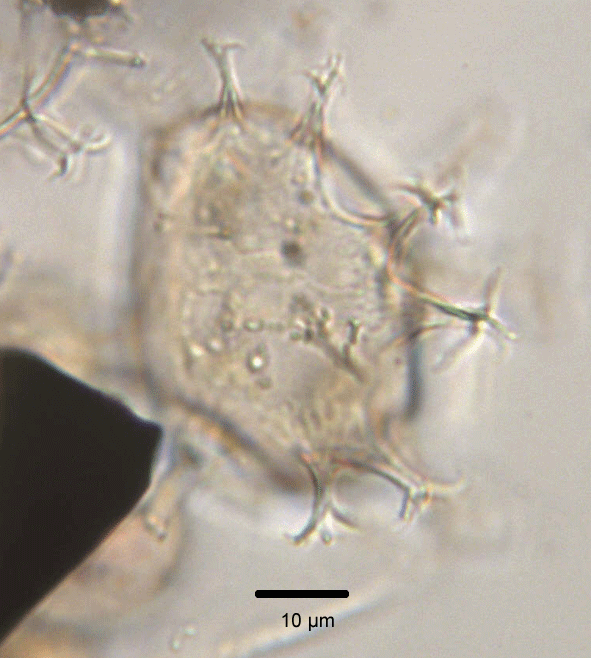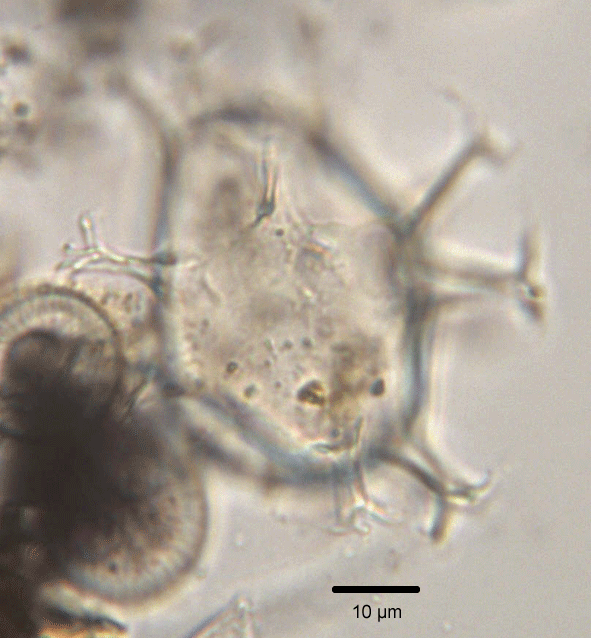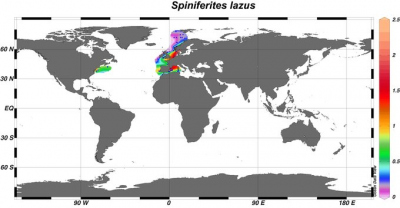Page path:
Spiniferites lazus
Zonneveld, K.A.F. and Pospelova V. (2015). A determination key for modern dinoflagellate cysts. Palynology 39 (3), 387- 407.


Field characteristics
Spiniferites lazus Reid 1974
Field charateristics:
Proximochorate cyst with an subspherical body, asymmetric in equatorial view and a distinct apical protuberance. The cell wall is microgranulate to reticulate. The processes are trifurcate with fenestrate bases and bifid recurved tips. Septa are rather low. There is an enlarged asymmetric septum at one of the antapical processes. Precingular archeopyle (3").
Dimensions: Cyst body: 31 to 42 (width) x 44 to 58 (length) µm; length of processes: 12 to 25 µm.
Comparison with other species:
This species can be easily recognised by it’s the fenestrate processes, asymmetrical antapical protubance and septa.
Field charateristics:
Proximochorate cyst with an subspherical body, asymmetric in equatorial view and a distinct apical protuberance. The cell wall is microgranulate to reticulate. The processes are trifurcate with fenestrate bases and bifid recurved tips. Septa are rather low. There is an enlarged asymmetric septum at one of the antapical processes. Precingular archeopyle (3").
Dimensions: Cyst body: 31 to 42 (width) x 44 to 58 (length) µm; length of processes: 12 to 25 µm.
Comparison with other species:
This species can be easily recognised by it’s the fenestrate processes, asymmetrical antapical protubance and septa.
Geographic distribution
Geographic distribution based on :
Zonneveld et al., 2013. Atlas of modern dinoflagellate cyst distribution based on 2405 datapoints. Review of Palaeobotany and Palynology, v. 191, 1-197
Zonneveld et al., 2013. Atlas of modern dinoflagellate cyst distribution based on 2405 datapoints. Review of Palaeobotany and Palynology, v. 191, 1-197
Spiniferites lazus is a sub-polar to temperate North Atlantic species that can be observed in full marine, coastal sites with elevated nitrate concentrations and well ventilated bottom waters.

Distribution:
Spiniferites lazus is restricted to the coastal sites of the temperate and sub-polar North Atlantic Ocean and the adjacent North Sea and Western Mediterranean Sea. Abundances are low (up to 2%) in the North Sea and Western Mediterranean Sea. High relative abundances occur in the upwelling area off the Iberian peninsula.
Environmental parameter range:
SST: 0.8 - 24.8°C (winter - summer) with summer SST > 4°C. SSS: 31.2 - 37.9 (summer - winter), [P]: 0.09 - 0.59 μmol/l, [N]: 1.22 - 7.80 μmol/l, chlorophyll-a: 0.2 - 2.4 ml/l, bottom waters [O2]: 4.4 - 7.0 ml/l.
Comparison with other records:
Spiniferites lazus has not been recorded from regions not covered by this Atlas.
Spiniferites lazus is restricted to the coastal sites of the temperate and sub-polar North Atlantic Ocean and the adjacent North Sea and Western Mediterranean Sea. Abundances are low (up to 2%) in the North Sea and Western Mediterranean Sea. High relative abundances occur in the upwelling area off the Iberian peninsula.
Environmental parameter range:
SST: 0.8 - 24.8°C (winter - summer) with summer SST > 4°C. SSS: 31.2 - 37.9 (summer - winter), [P]: 0.09 - 0.59 μmol/l, [N]: 1.22 - 7.80 μmol/l, chlorophyll-a: 0.2 - 2.4 ml/l, bottom waters [O2]: 4.4 - 7.0 ml/l.
Comparison with other records:
Spiniferites lazus has not been recorded from regions not covered by this Atlas.


